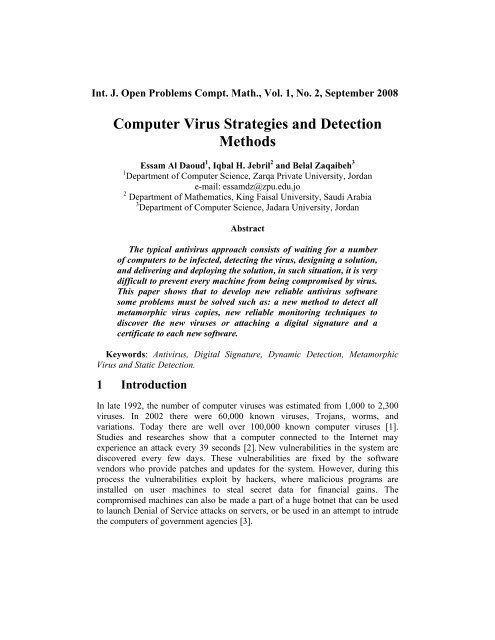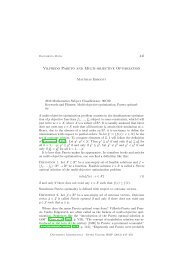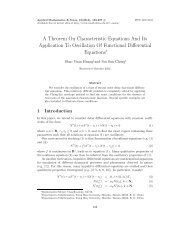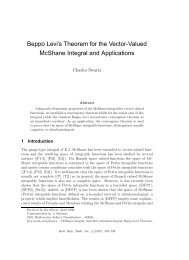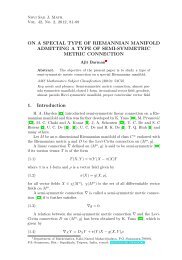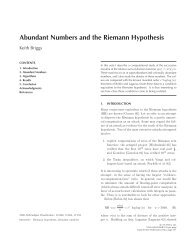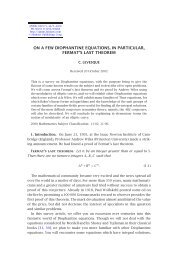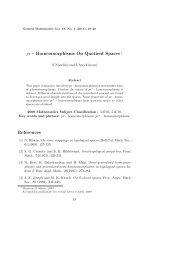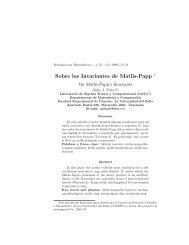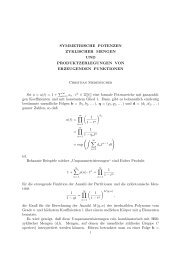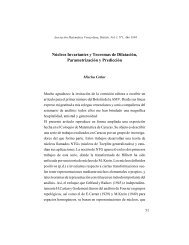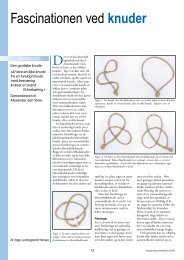Computer Virus Strategies and Detection Methods
Computer Virus Strategies and Detection Methods
Computer Virus Strategies and Detection Methods
You also want an ePaper? Increase the reach of your titles
YUMPU automatically turns print PDFs into web optimized ePapers that Google loves.
Int. J. Open Problems Compt. Math., Vol. 1, No. 2, September 2008<br />
<strong>Computer</strong> <strong>Virus</strong> <strong>Strategies</strong> <strong>and</strong> <strong>Detection</strong><br />
<strong>Methods</strong><br />
Essam Al Daoud 1 , Iqbal H. Jebril 2 <strong>and</strong> Belal Zaqaibeh 3<br />
1 Department of <strong>Computer</strong> Science, Zarqa Private University, Jordan<br />
e-mail: essamdz@zpu.edu.jo<br />
2 Department of Mathematics, King Faisal University, Saudi Arabia<br />
3 Department of <strong>Computer</strong> Science, Jadara University, Jordan<br />
Abstract<br />
The typical antivirus approach consists of waiting for a number<br />
of computers to be infected, detecting the virus, designing a solution,<br />
<strong>and</strong> delivering <strong>and</strong> deploying the solution, in such situation, it is very<br />
difficult to prevent every machine from being compromised by virus.<br />
This paper shows that to develop new reliable antivirus software<br />
some problems must be solved such as: a new method to detect all<br />
metamorphic virus copies, new reliable monitoring techniques to<br />
discover the new viruses or attaching a digital signature <strong>and</strong> a<br />
certificate to each new software.<br />
Keywords: Antivirus, Digital Signature, Dynamic <strong>Detection</strong>, Metamorphic<br />
<strong>Virus</strong> <strong>and</strong> Static <strong>Detection</strong>.<br />
1 Introduction<br />
In late 1992, the number of computer viruses was estimated from 1,000 to 2,300<br />
viruses. In 2002 there were 60,000 known viruses, Trojans, worms, <strong>and</strong><br />
variations. Today there are well over 100,000 known computer viruses [1].<br />
Studies <strong>and</strong> researches show that a computer connected to the Internet may<br />
experience an attack every 39 seconds [2]. New vulnerabilities in the system are<br />
discovered every few days. These vulnerabilities are fixed by the software<br />
vendors who provide patches <strong>and</strong> updates for the system. However, during this<br />
process the vulnerabilities exploit by hackers, where malicious programs are<br />
installed on user machines to steal secret data for financial gains. The<br />
compromised machines can also be made a part of a huge botnet that can be used<br />
to launch Denial of Service attacks on servers, or be used in an attempt to intrude<br />
the computers of government agencies [3].
Essam Al Daoud et al.<br />
Unfortunately, our current ability to defend against new viruses is extremely poor<br />
<strong>and</strong> the basic approach of detection, characterization, <strong>and</strong> containment has not<br />
changed significantly over the last five years. The complexity of modern malware<br />
is making this problem more difficult. For example, Agobot, has been observed to<br />
have more than 580 variants since its initial release. Modern Agobot variants have<br />
the ability to perform denial of service attacks, steal bank passwords <strong>and</strong> account<br />
details, propagate over the network using a diverse set of remote exploits, use<br />
polymorphism to evade detection <strong>and</strong> disassembly [4].<br />
<strong>Computer</strong> virus writers use many strategies to evade detection such as space<br />
filling, compressing <strong>and</strong> encryption, in another h<strong>and</strong>; the antivirus software trying<br />
to detect the viruses by using variant static <strong>and</strong> dynamic methods. However; all<br />
the existing methods are not adequate. To develop new reliable antivirus software<br />
some problems must be fixed. Antivirus open problems are introduced at the end<br />
of this paper.<br />
2 <strong>Strategies</strong> of <strong>Computer</strong> virus<br />
A computer virus is a computer program that can copy itself <strong>and</strong> infect a computer<br />
without permission or knowledge of the user. In order to avoid detection by users,<br />
some viruses employ different kinds of deception such as the following<br />
<strong>Strategies</strong>[5], [6]:<br />
• Overwriting <strong>Virus</strong>: this type of virus overwrites files with their own copy.<br />
Of course, this is a very primitive technique, but it is certainly the easiest<br />
approach of all. Overwriting viruses cannot be disinfected from a system.<br />
Infected files must be deleted from the disk.<br />
• Companion Infection: one approach to becoming a companion to an EXE<br />
file is to give the virus the same base name as the targeted program, but use a<br />
.COM extension instead of .EXE. This technique was employed by the Globe<br />
virus, first detected in 1992. When the victim attempts to launch an EXE<br />
program, he or she usually types its name without the extension. In such<br />
cases, Windows gives priority to a file with the .COM extension over a file<br />
with the same base name but with the .EXE extension.<br />
• Appending <strong>Virus</strong>: In this technique, a jump (JMP) instruction is inserted at<br />
the front of the host to point to the end of the original host. A typical example<br />
of this virus is Vienna. The appender technique can be implemented for any<br />
other type of executable file, such as EXE, NE, PE, <strong>and</strong> ELF formats, <strong>and</strong> so<br />
on. Such files have a header section that stores the address of the main entry<br />
point, which, in most cases, will be replaced with a new entry point to the<br />
start of the virus code appended to the end of the file.<br />
• Prepending <strong>Virus</strong>: This virus inserts its code at the front of host programs.<br />
This is a simple kind of infection, <strong>and</strong> it is often very successful. <strong>Virus</strong><br />
30
31 <strong>Computer</strong> <strong>Virus</strong> <strong>Strategies</strong> <strong>and</strong> <strong>Detection</strong> <strong>Methods</strong><br />
writers have implemented it on various operating systems, causing major<br />
virus outbreaks in many. An example of a COM prepender virus is the<br />
Hungarian virus Polimer.512.A, which prepends itself, 512 bytes long, at the<br />
front of the executable <strong>and</strong> shifts the original program content to follow itself.<br />
• Cavity or spacefiller <strong>Virus</strong>: This virus attempts to install itself in this empty<br />
space while not damaging the actual program itself. An advantage of this is<br />
that the virus then does not increase the length of the program <strong>and</strong> can avoid<br />
the need for some stealth techniques. The Lehigh virus was an early example<br />
of a cavity virus. Because of the difficulty of writing this type of virus <strong>and</strong> the<br />
limited number of possible hosts, cavity viruses are rare.<br />
• Compressing <strong>Virus</strong>: A special virus infection technique uses the approach of<br />
compressing the content of the host program. Sometimes this technique is<br />
used to hide the host program's size increase after the infection by packing<br />
the host program sufficiently with a binary packing algorithm.<br />
• Encrypted <strong>Virus</strong>: consists of a constant decryptor, followed by the encrypted<br />
virus body. Relatively easy to detect because decryptor is constant. The first<br />
known virus that implemented encryption was Cascade on DOS.<br />
Oligomorphic virus changes its decryptors in new generations. The simplest<br />
technique to change the decryptors is to use a set of decryptors instead of a<br />
single one. The first known virus to use this technique was Whale. Whale<br />
carried a few dozen different decryptors, <strong>and</strong> the virus picked one r<strong>and</strong>omly.<br />
• Boot Sectors <strong>Virus</strong>: this virus takes advantage of the executable nature of<br />
master boot record (MBR) <strong>and</strong> partition boot sector (PBS). A PC infected<br />
with a boot sector virus will execute the virus's code when the machine boots<br />
up. Michelangelo virus is an example of a Boot Sectors <strong>Virus</strong>.<br />
• macro virus: infects a Microsoft Word or similar application <strong>and</strong> causes a<br />
sequence of actions to be performed automatically when the application is<br />
started or something else triggers it. Macro viruses tend to be surprising but<br />
relatively harmless. A typical effect is the undesired insertion of some comic<br />
text at certain points when writing a line. A macro virus is often spread as an<br />
e-mail virus. A well-known example in March, 1999 was the Melissa virus.<br />
• Malicious mobile code (MMC): mobile code is a lightweight program that is<br />
downloaded from a remote system <strong>and</strong> executed locally with minimal or no<br />
user intervention. Java applets, JavaScript scripts, Visual Basic Scripts<br />
(VBScripts), <strong>and</strong> ActiveX controls are some of the most popular examples of<br />
mobile code that you may encounter while browsing the Web or reading<br />
HTML-formatted e-mail. An attacker might use mobile code for a variety of<br />
nasty activities, including monitoring your browsing activities, obtaining<br />
unauthorized access to your file system, infecting your machine with a Trojan<br />
horse, hijacking your Web browser to visit sites that you did not intend to<br />
visit, <strong>and</strong> so on.
Essam Al Daoud et al.<br />
3 Static <strong>Detection</strong> <strong>Methods</strong><br />
With static analysis, a virus is detected by examining the files or records for the<br />
occurrences of virus patterns without actually running any code. Static <strong>Methods</strong><br />
include the following methods [7]:<br />
• String Scanning method: Searches for sequence of bytes (strings) that are<br />
typical of a specific virus but not likely to be found in other programs.<br />
• Wildcards method: allows to skip bytes or byte ranges. For example "?"<br />
character are skipped <strong>and</strong> the wildcard % means that the scanner will try to<br />
match the next byte.<br />
• Mismatches method: allows any given number of bytes in a string to be of<br />
arbitrary value, regardless of their position.<br />
• Generic <strong>Detection</strong> method: This technique uses one common string to detect<br />
several or all known variants of a family of viruses.<br />
• Bookmarks method: calculates the distance between the start of the virus<br />
body <strong>and</strong> the detection string.<br />
• Smart Scanning: Smart scanning could skip junk instructions, such as NOPs,<br />
in the host file <strong>and</strong> also did not store them in the virus signature. To enhance<br />
the likelihood of detecting related variants of viruses, an area of the virus body<br />
was selected which had no references to data or other subroutines.<br />
• Skeleton <strong>Detection</strong>: The scanner parses the statements of the virus line-by-line<br />
<strong>and</strong> drops all nonessential statements. What is left is the skeleton of the body<br />
that has only essential macro code common in macro virus.<br />
• Heuristics Analysis: Heuristic analysis is an expert based analysis that<br />
determines the susceptibility of a system towards particular threat/risk using<br />
various decision rules or weighing methods. MultiCriteria analysis (MCA) is<br />
one of the means of weighing.<br />
• <strong>Virus</strong> specific detection: There are cases when the st<strong>and</strong>ard algorithm of the<br />
virus scanner cannot deal with a virus. In cases like this, a new detection code<br />
must be introduced to implement a virus-specific detection algorithm. This<br />
method includes Filtering, Decryptor <strong>Detection</strong> <strong>and</strong> X-Ray scanning.<br />
4 Dynamic <strong>Detection</strong> <strong>Methods</strong><br />
Dynamic detection method decides whether or not code is infected by running the<br />
code <strong>and</strong> observing its behavior. The program monitors known methods of virus<br />
activity including attempts to infect <strong>and</strong> evade detection. This may also include<br />
attempts to write to boot sectors, modify interrupt vectors, write to system files,<br />
etc. For example, most virus activity eventually needs to call some system<br />
functionality, like I/O operations - only these actions have to be considered. No<br />
matter how obfuscated the I/O calls are statically, the calls will appear clearly<br />
when the code runs. Software monitors work best when the normal usage<br />
32
33 <strong>Computer</strong> <strong>Virus</strong> <strong>Strategies</strong> <strong>and</strong> <strong>Detection</strong> <strong>Methods</strong><br />
characteristics of the system are vastly different from the activity profile of an<br />
infected system. A virus might exhibit a dynamic signature like [6]:<br />
• Opening an executable, with both read <strong>and</strong> write permission.<br />
• Reading the portion of the file header containing the executable's start<br />
address.<br />
• Writing the same portion of the file header.<br />
• Seeking to the end of the file.<br />
• Appending to the file.<br />
A behavior blocker is antivirus software which monitors a running program's<br />
behavior in real time, watching for suspicious activity. If such activity is seen, the<br />
behavior blocker can prevent the suspect operations from succeeding, can<br />
terminate the program, or can ask the user for the appropriate action to perform.<br />
Behavior blocking allowed code to run on the real machine. In contrast, antivirus<br />
techniques using emulation let the code being analyzed run in an emulated<br />
environment. The hope is that, under emulation, a virus will reveal itself. Because<br />
any virus found wouldn't be running on the real computer, no harm is done.<br />
5 Metamorphic <strong>Virus</strong><br />
Metamorphic <strong>Virus</strong> can reprogram itself. it use code obfuscation techniques to<br />
challenge deeper static analysis <strong>and</strong> can also beat dynamic analyzers by altering<br />
its behavior, it does this by translating its own code into a temporary<br />
representation, edit the temporary representation of itself, <strong>and</strong> then write itself<br />
back to normal code again. This procedure is done with the virus itself, <strong>and</strong> thus<br />
also the metamorphic engine itself undergoes changes. Metamorphic viruses use<br />
several metamorphic transformations, including Instruction reordering, data<br />
reordering, inlining <strong>and</strong> outlining, register renaming, code permutation, code<br />
expansion, code shrinking, Subroutine interleaving, <strong>and</strong> garbage code insertion.<br />
The altered code is then recompiled to create a virus executable that looks<br />
fundamentally different from the original. For example, here is the original code<br />
of a target before instruction replacement [7], [8]:<br />
55<br />
8BEC<br />
8B7608<br />
85F6<br />
743B<br />
8B7E0C<br />
09FF<br />
7434<br />
31D2<br />
push ebp<br />
mov ebp, esp<br />
mov esi, dword ptr [ebp + 08]<br />
test esi, esi<br />
je 401045<br />
mov edi, dword ptr [ebp + 0c]<br />
or edi, edi<br />
je 401045<br />
xor edx, edx
Essam Al Daoud et al.<br />
<strong>and</strong> here is the original code of a target after instruction replacement<br />
55<br />
54<br />
5D<br />
8B7608<br />
09F6<br />
743B<br />
8B7E0C<br />
85FF<br />
7434<br />
28D2<br />
push ebp<br />
push esp ; register move replaced by<br />
push/pop<br />
pop ebp ; register move replaced by<br />
push/pop<br />
mov esi, dword ptr [ebp + 08]<br />
or esi, esi ; test/or interchange<br />
je 401045<br />
mov edi, dword ptr [ebp + 0c]<br />
test edi, edi ; test/or interchange<br />
je 401045<br />
sub edx, edx ; xor/sub interchange<br />
Figure 1 shows an example of inserting jumps into code (Zperm virus) [9]:<br />
Figure 1: Example of Zperm inserting jumps into its code<br />
In general any metamorphic virus must perform the following steps[10]:<br />
• Locate own code: Each time a metamorphic engine is called to transform<br />
some code, it must be able to locate their own code in the new variants.<br />
• Decode: Next, the engine needs to decode the information required to perform<br />
the transformations. In order to transform itself, the engine must have some<br />
representation of itself so that it knows how to make the transformations.<br />
• Analyze: In order for the metamorphic transformations to work correctly,<br />
certain information must be available. For some transformations to be<br />
performed correctly, the engine must have register liveness information<br />
available. If such information is not available, the metamorphic engine itself<br />
must construct it. A piece of information that is frequently required for<br />
analysis <strong>and</strong> transformation, is the control flow graph (CFG) of the program.<br />
34
35 <strong>Computer</strong> <strong>Virus</strong> <strong>Strategies</strong> <strong>and</strong> <strong>Detection</strong> <strong>Methods</strong><br />
• Transform: This unit is responsible for transforming the code into equivalent<br />
code. This is done usually by replacing instruction blocks in the code with<br />
other equivalent.<br />
• Attach: The last step is attaching the new generation of the virus to a new host<br />
file.<br />
6 Antivirus Open Problems<br />
<strong>Detection</strong> <strong>Methods</strong> have some major problems. Firstly, they are only good against<br />
known viruses <strong>and</strong> not very good against evolutionary or new viruses. Secondary,<br />
they tend to take a noticeable amount of time to scan a system or networks for the<br />
patterns. Thirdly, a scanner or its virus pattern database must be updated very<br />
often to remain effective. Subsequence the following problems must be solved:<br />
• If the virus is cleverly written to always stay within this normal behavior, it<br />
may be difficult to detect its presence using the current monitoring techniques.<br />
Can we introduce new reliable monitoring techniques to discover the new<br />
viruses?<br />
• Metamorphic viruses are difficult to detect because their creators have the<br />
advantage of knowing the weaknesses of antivirus scanners. The limits of<br />
antivirus scanners come from the limits of static <strong>and</strong> dynamic analysis<br />
techniques. If we have some copies of a metamorphic virus, is there a new<br />
method to detect all metamorphic virus copies?<br />
• Can we use public key cryptography to solve the computer virus problem? In<br />
this case all the developers must embed their digital signature within their<br />
software <strong>and</strong> they must prepare a certificate that is signed by a will known<br />
certificate authority. The developers of operating systems must offer a new<br />
procedure to copy, download <strong>and</strong> install the new software.<br />
References<br />
[1] http://www.cknow.com/vtutor/Numberof<strong>Virus</strong>es.html. Last access on<br />
July (2008)<br />
[2] http://csdl2.computer.org/comp/mags/it/2007/02/f2004.pdf. Last access on<br />
July (2008)<br />
[3] R. Srinivasan , Protecting Anti-<strong>Virus</strong> Software Under Viral Attacks, Master<br />
Degree of Science, Arizona State University (2007).<br />
[4] M. Bailey, J. Oberheide, J. Andersen, Z. M. Mao, F. Jahanian, <strong>and</strong> J. Nazario,<br />
"Automated classification <strong>and</strong> analysis of internet malware", In Proceedings<br />
of the 10th Symposium on Recent Advances in Intrusion <strong>Detection</strong> (RAID’07),<br />
(2007), pp 178–197.<br />
[5] J. cock, <strong>Computer</strong> <strong>Virus</strong>es <strong>and</strong> Malware, Springer (2006 )
Essam Al Daoud et al.<br />
[6] E. Skoudis <strong>and</strong> L. Zeltser, Malware: Fighting Malicious Code, Prentice<br />
Hall (2003)<br />
[7] P. Szor, The Art of <strong>Computer</strong> <strong>Virus</strong> Research <strong>and</strong> Defense. Addison<br />
Wesley, (2005)<br />
[8] E. Konstantinou, "Metamorphic <strong>Virus</strong>: Analysis <strong>and</strong> <strong>Detection</strong>", Technical<br />
Report RHUL-MA-2008-02, (2008)<br />
[9] P. Szor <strong>and</strong> P. Ferrie, "Hunting for metamorphic", In <strong>Virus</strong> Bulletin<br />
Conference, Prague, Czech Republic Vecna (1998). Miss Lexotan,8, 29A E-<br />
Zine (2001)<br />
[10] A. Walenstein, R. Mathur, R. Mohamed, R. Chouchane <strong>and</strong> A. Lakhotia.<br />
"The design space of metamorphic malware", In Proceedings of the 2nd<br />
International Conference on Information Warfare, (2007).<br />
36


